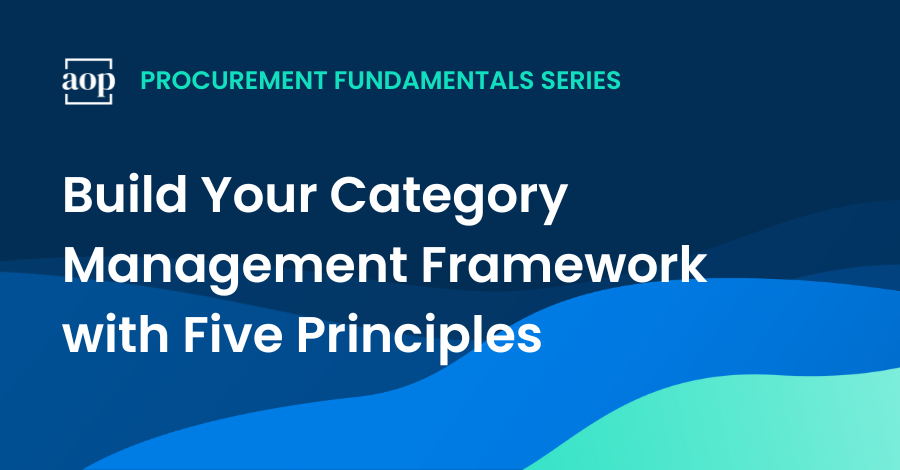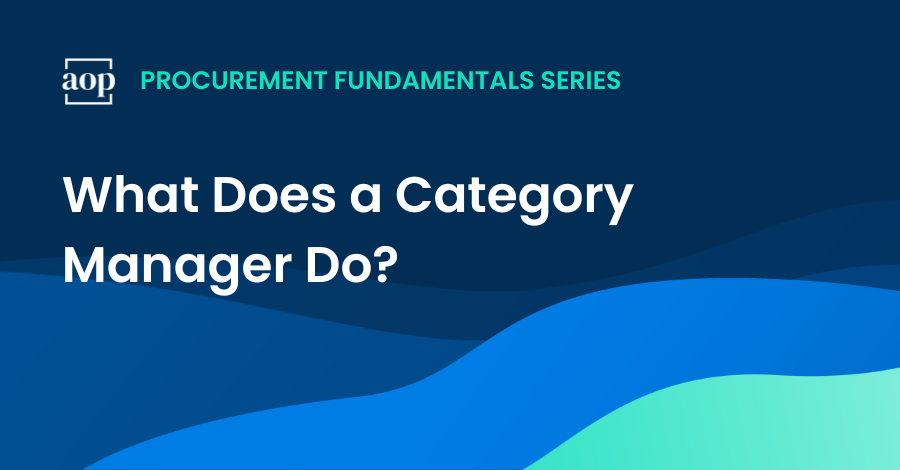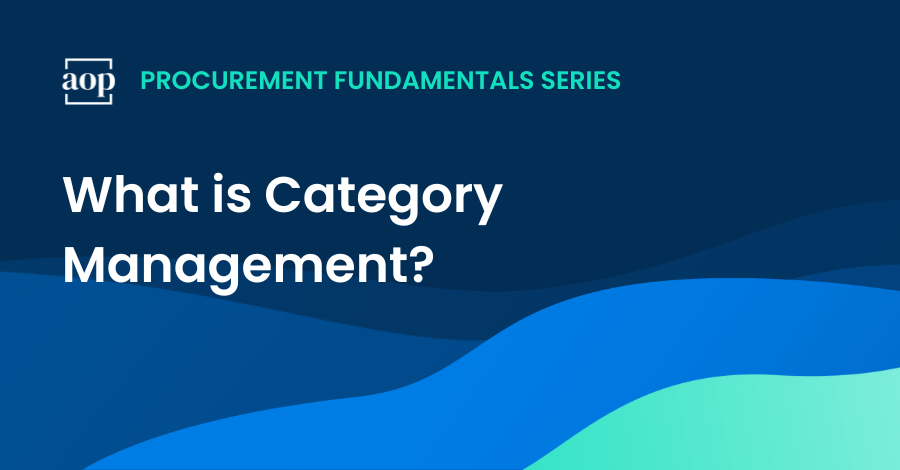7 min read
Build Your Category Management Framework with Five Evergreen Principles
Philip Ideson : April 30, 2024

There is no standard approach to category management. Every organization, procurement leader, and category manager must build a plan to suit their own needs.
While you can’t follow one clear guidebook, category management best practices are becoming better defined through data-driven industry research. In episode 118 of the Art of Procurement podcast, we hear from Mark Webb about the key findings of the Global Category Management Research Report.
The insights Mark shares with us are applicable to any procurement leader or category manager looking to build their own category management framework. Before we go through his five evergreen principles, let’s review some core definitions.
Why is category management important?
Category management is more than just a way to ‘do procurement;’ it can be a unifying business strategy that impacts your company’s bottom line and drives operational efficiency.
Category management is important to get right. According to the global report published by Future Purchasing, category management is a top 3 priority for 70 percent of procurement teams surveyed.
As Mark Webb puts it during his discussion on the Art of Procurement podcast, “Category management is often treated as a more functional, siloed process… what we really want it to be is a business process.” This shift from a functional to a strategic focus is crucial for procurement leaders looking to enhance their influence and value within their organizations.
Foundations that make good up category management
Before we even get to the five principles you can use to build your category management framework, let’s go through three foundations that make up good category management practices in any procurement organization.
Strategy integrated with business goals
Without aligning with business objectives, your category strategy is just a category plan. The first foundation to any category management framework is found within goals that extend beyond the needs of procurement.
According to Webb, “It’s about how do we really work closely with business partners and get to a place where we can unlock all the value from spend just by being much closer to people and working all of the different opportunities that are available within a category.” This approach calls for a deep dive into understanding business units’ needs, priorities, and challenges, ensuring that category strategies are not only compliant but proactive in addressing key business issues.
Define business-aligned goals
Another foundation you need to get right is to define goals that align with broader business objectives. Procurement activity that simply focuses on cost savings and supplier relationships cannot have the same level of impact.
“We get lots of requests from CPOs and leadership team members that are really all focused around trying to break out from this mentality of it’s just procurement doing things on its own,” Webb mentions. This alignment ensures that every category management effort directly supports overarching business goals, making your role both valuable and strategic.
Nurture continuous improvement
Any procurement organization is like a living, breathing organism. Rarely do things stay the same for very long. Fortunately, category management benefits from a culture of continuous improvement.
This means regularly revisiting and refining your category management processes based on feedback, performance data, and evolving business needs. Webb’s insights underline the importance of staying adaptable and responsive: “It’s not prescriptive but it was the idea of pulling together the sort of experience that we’d had and the best practices we’d seen clients do.”
Five principles for your category management framework
You can think of a category management framework as a set of good practices that ensure your organization follows the agreed upon processes, goals and objectives to a consistently high standard. In this case, it’s less of a “what to do” and more of a “how to do” set of principles to follow when you’re building out a category management team.
Based on Mark Webb’s research and experience, the five principles to inspire your category management framework are as follows:
- Enable meaningful stakeholder engagement
- Nurture on-the-job learning and recognition
- Leverage technology as an enabler
- Build a culture of collaboration
- Deliver accountability and clear objectives
1. Enable meaningful stakeholder engagement
Getting your stakeholders on board is more than half the battle in effective category management. As Webb points out, transitioning category management into a collaborative business process means moving beyond the procurement silo and embracing a more integrated approach. “We see category management as something that should be a business process,” he notes, emphasizing the importance of building strong relationships with stakeholders across the organization.
Identify and engage key stakeholders
First things first: identify who your key stakeholders are. These are the decision-makers and influencers in various departments who will feel the direct impact of category-level decisions. Understanding their needs, concerns, and expectations is crucial. This isn’t just about meeting them; it’s about integrating their visions into your procurement strategy to ensure alignment and buy-in from the start.
Improve communication channels
Don’t underestimate the importance of communication. This means setting up regular meetings, creating shared digital spaces for updates and feedback, and establishing clear, open lines of communication. “It’s about breaking out from this mentality of it’s just procurement doing things on its own,” Webb emphasizes. When stakeholders are involved from the beginning, not only in decision-making but also in the planning phase, the whole procurement process becomes more transparent and trusted.
Sell the outcome
A third point about stakeholder engagement Webb emphasizes is that communications needs to be directed at senior leadership in the cycle of business planning “this is about selling it at the top internally and not trying to drive something bottom up.”
2. Nurture on-the-job learning and recognition
Category managers who know their job requirements well perform well. Mark Webb stresses the need for a structured approach to training that goes beyond traditional classroom settings. “On the job learning experience is planning those. That’s entirely within the gift of procurement,” Webb explains. This practical approach ensures that your team not only learns theoretical best practices but also applies them in real-world scenarios, which is essential for their development.
Build learning pathways
Create structured learning pathways that include a mix of formal education, on-the-job training, and mentorship. Webb mentions the 70/20/10 model, where 70 percent of learning comes from experience, 20 percent comes from working with others and 10 percent comes through formal training.
Encourage your team to engage in live projects as part of their learning process. This will help them understand the nuances of category management in a controlled, yet dynamic environment. Webb suggests focusing on the practical application of learned skills, which can significantly enhance the effectiveness of the training.
Focus on soft skills
While technical skills are important, Webb highlights the value of soft skills in category management. Skills like negotiation, strategic thinking, and active listening should not be underestimated. “It requires some organization and you need to know the pipeline of projects and you need to know the competency gaps,” he notes. Incorporate soft skills training into your development programs to ensure your team can effectively problem solve and collaborate with others across the organization.
3. Leverage technology as an enabler
Technology plays a key role in category management by providing tools that streamline processes and support decision-making capabilities. Webb discusses the importance of integrating technology with category management practices to maximize efficiency and effectiveness.
Digital tools and solutions
According to Webb, procurement teams have historically been slow to leverage technology, but this is changing. “Procurement teams have been fairly weak at gaining access to information and knowledge management. Having central repositories and up to date information that anybody can access will change that. Things are changing rapidly. I think we’ll see a massive difference in two years around that question.”
Data-driven decision making
Embrace a data-driven decision-making process. “Here’s some evidence from real organizations and they are doing these things and we can say that the leaders are doing certain things therefore it’s worthy of consideration,” Webb states. Use the data collected through your digital tools to inform your category strategies and adjust them in real-time based on actual performance metrics and changing market conditions.
4. Build a culture of collaboration
One interesting finding from the global category management report developed by Webb and Future Purchasing is that 50 percent of the time procurement works on category strategy on their own. From a stakeholder perspective, you need to show value demonstrated beyond procurement to all parts of the organization – and, just as importantly, capture their input.
Break down silos
To foster this culture of collaboration, start by actively breaking down silos between procurement and other departments. Webb suggests, “It’s about how we really work closely with business partners and get to a place where we can unlock all the value from spend just by being much closer to people.” Encourage regular cross-departmental meetings and shared projects to build mutual understanding and trust.
Foster a team-oriented environment
Promote a team-oriented approach where category management is seen as a shared responsibility. This doesn’t mean just involving stakeholders in discussions but also in decision-making processes beyond supplier selection. As Webb points out, aligning everyone’s objectives towards common goals and getting stakeholder accountability for category management targets is key. This approach ensures that everyone feels ownership over the outcomes, thereby increasing engagement and commitment.
Be a broker of innovation
In an effective procurement organization, category management is a broker of innovation. Foster an environment where innovative ideas are welcomed and tested. Encourage your team to think creatively about how to improve procurement processes and outcomes. As Webb notes, moving beyond traditional methods and exploring new possibilities is essential for growth and improvement in procurement.
5. Deliver accountability and clear objectives
According to the report findings, only 20 percent of procurement teams had clearly defined objectives. Webb discusses the importance of linking these metrics directly to business outcomes to highlight the value procurement brings to the table.
Select appropriate metrics
Choose KPIs that reflect not only savings but also the strategic contributions of procurement, such as risk mitigation, innovation, and revenue impacts. Webb indicates, “It’s about time spent creating something which is an innovative strategy and is practical and working much more closely hand in hand with stakeholders to do that.” This broader set of metrics can better demonstrate procurement’s full value to the organization.
Regular review and adjustment
It’s not enough to set metrics; you must also regularly review and adjust them to stay relevant with business needs. Webb’s advice implies that a dynamic approach to KPIs, one that evolves with the business landscape and internal company strategy, is most effective. Regularly revisiting these metrics ensures that they remain aligned with your strategic objectives and continue to drive meaningful decisions.
Benchmarking against leaders
Webb discusses the findings from the Global Category Management Leadership Report, revealing that leaders in category management don’t just follow best practices; they set them. “The leaders are doing certain things therefore they’re worthy of consideration,” he advises. Look into what these leaders are doing differently—be it their strategic approach, the technologies they employ, or how they handle supplier relationships—and evaluate how these strategies might be adapted to your organization’s unique context.
Key takeaways for building a category management framework
As we wrap up, remember that category management is a dynamic and strategic discipline that requires constant attention and refinement. Mark Webb’s insights from the podcast episode highlight that with the right approach, tools, and mindset, procurement leaders can transform category management into a critical business function.
For more tips, visit our Category Management Best Practice Hub.
Hear more expert views on category management
Expand your understanding of category management through these expert interviews on the Art of Procurement podcast:
- Advanced Category Management: Organizational Building Blocks with Lynn Rideout and Chris Eyermann
- Advanced Category Management: Category Mangement Imperatives with Lynn Rideout and Chris Eyermann
- How to Engage with Skeptical Stakeholders to Build Effective Category Strategies with Bill Michels
- Navigating the Perfect Storm Using Category Management with Stephane Morel







